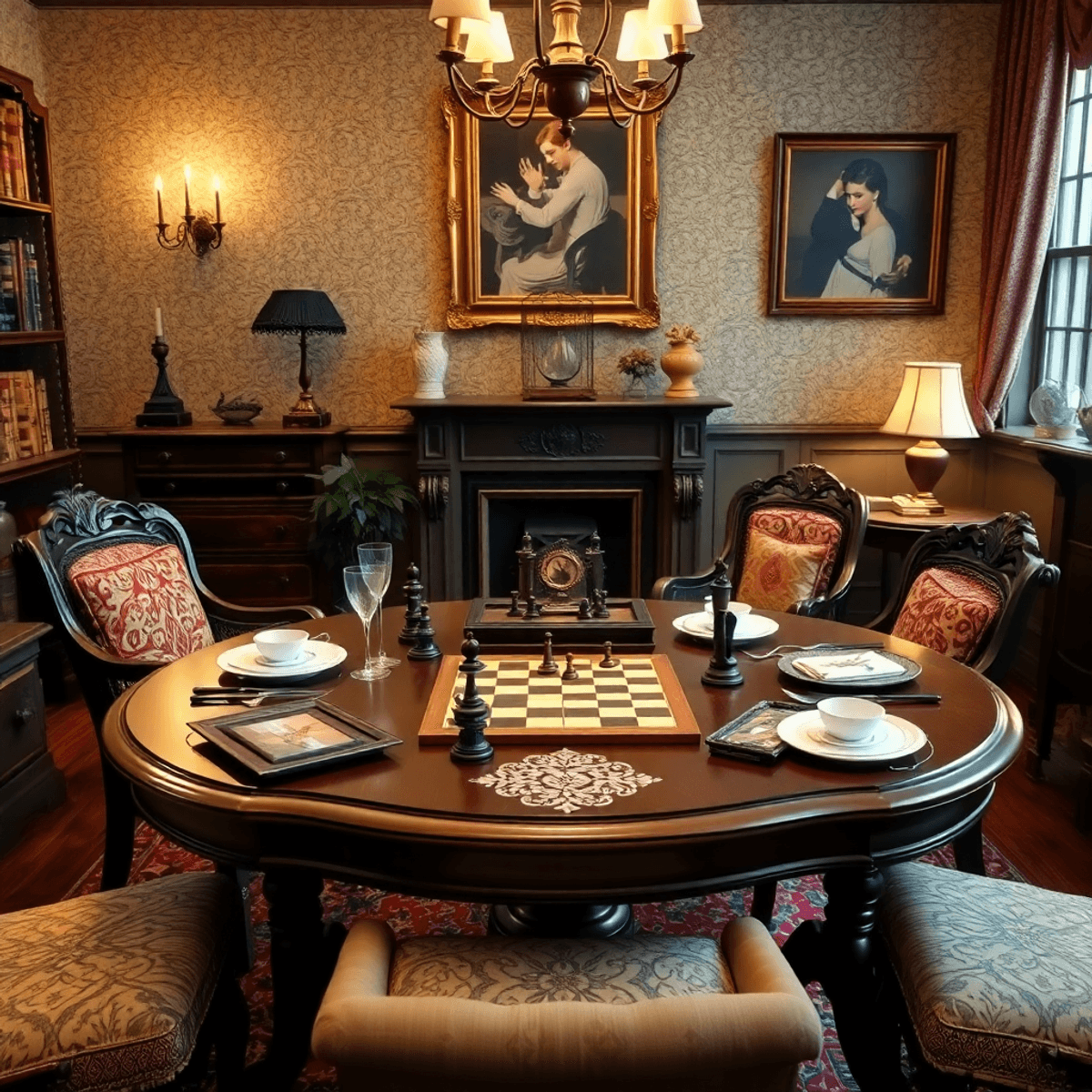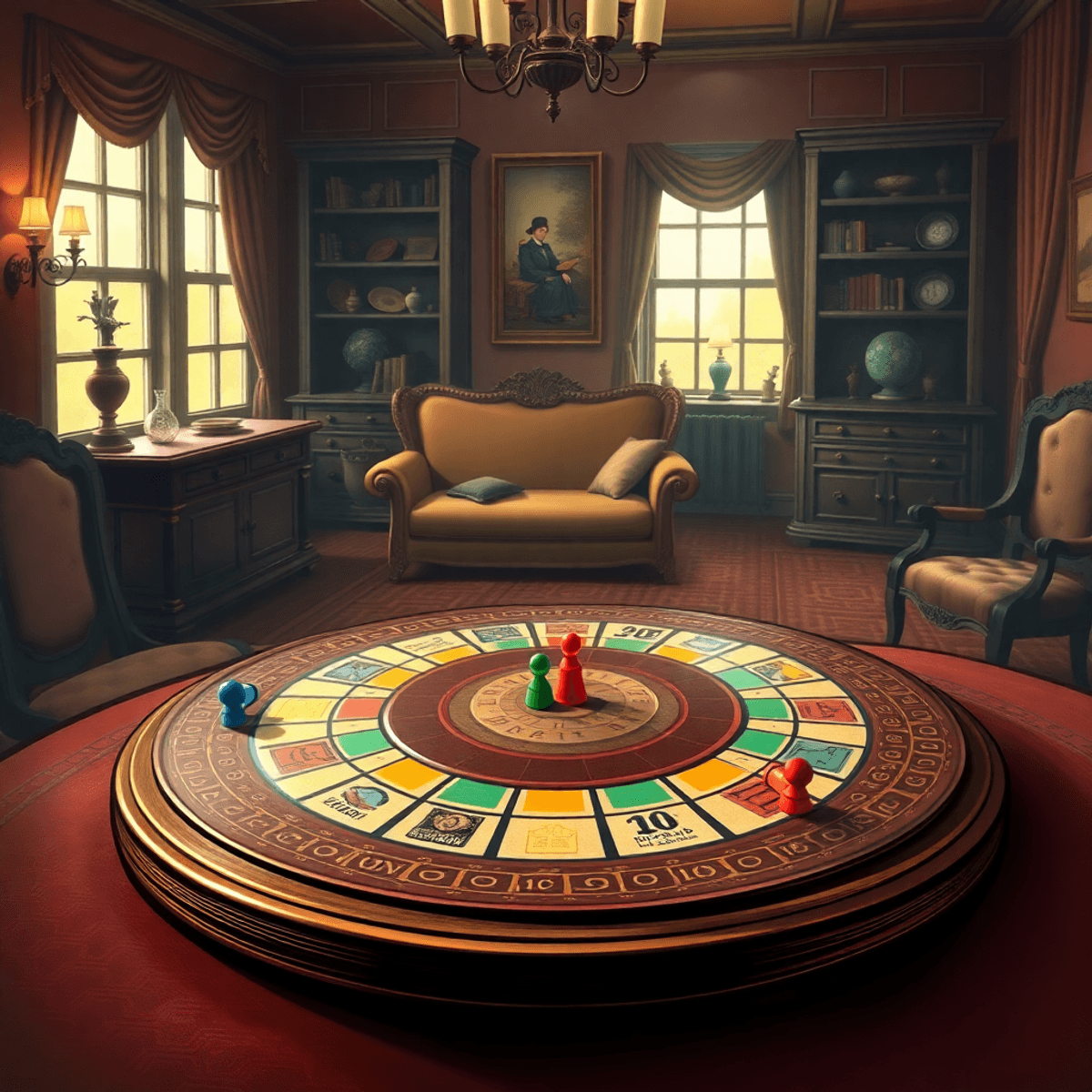
The Victorian era was a time of great change in the world of leisure activities, with board games and parlor games becoming popular forms of social entertainment. These games were more than just ways to pass the time – they reflected the cultural values, social dynamics, and technological advancements of the 19th and early 20th centuries.
In Victorian homes, the parlor was the center of social interaction. Families and guests would come together to play games like chess, solve riddles, or enjoy a game of whist. These gaming sessions not only provided entertainment but also reinforced the social manners and moral principles that were important to Victorian society.
How the Industrial Revolution Changed Board Gaming
The Industrial Revolution brought about significant changes to the world of board gaming:
- New printing methods made it easier to produce game boards and cards.
- Factories could now mass-produce game pieces, making them more affordable.
- Improved transportation systems allowed games to be distributed widely.
- The rising middle class had more free time to spend on leisure activities.
These changes made board games accessible to more people, turning them from luxury items into things that many households owned. Companies like Milton Bradley and Parker Brothers played a key role in this transformation by standardizing production methods and introducing innovative game designs.
The Impact of Victorian Board Games on Modern Gaming
The development of board games during the Victorian era laid the groundwork for modern tabletop gaming. Many of the conventions and mechanics used in today’s games can be traced back to this period.
The legacy of parlor entertainment also provides valuable insights into how societies adapt their leisure activities over time while still preserving fundamental aspects of human interaction and competition.
Popular Board and Parlor Games from the Victorian Era
The Victorian middle and upper classes embraced parlor games as a sophisticated form of entertainment, creating social bonds through shared leisure activities. These games ranged from simple card games to elaborate theatrical performances, each designed to showcase wit, skill, and social grace.
Popular Victorian Parlor Games:
- Charades – Players acted out words or phrases through elaborate mime performances, often incorporating props and costumes
- Whist – A strategic card game that preceded modern bridge, played in formal gatherings and dedicated clubs
- Squails – A tabletop game similar to carrom, where players flicked wooden discs to hit targets
- Bagatelle – A precursor to pinball, played on an inclined board with balls and pins
Indoor pastimes extended beyond traditional board games, incorporating intellectual pursuits that showcased Victorian values of education and refinement:
- Word Making and Word Taking – Players constructed and deconstructed words from letter tiles
- Categories – Participants listed items within specific themes against a time limit
- Mechanical Puzzles – Intricate wooden or metal contraptions testing dexterity
- Picture Puzzles – Early jigsaw puzzles, often depicting historical scenes
The social significance of these games extended beyond mere entertainment. Victorian parlor games served as:
- Matchmaking opportunities for young adults
- Displays of educational accomplishment
- Platforms for practicing social etiquette
- Venues for networking among business associates
Many games required specific equipment, leading to the production of elegant gaming tables, specialized card holders, and decorative game pieces that doubled as home decor. These artifacts reflected the Victorian appreciation for both form and function in their leisure pursuits.
The rise of dedicated game rooms in Victorian homes highlighted the importance of these social pastimes. These spaces featured built-in storage
Outdoor Games in Victorian Times
Victorian outdoor games were a perfect combination of physical activity and social etiquette. The well-kept lawns of Victorian estates provided ideal settings for sophisticated outdoor entertainment that followed strict social rules.
Popular Outdoor Games
Some of the most popular outdoor games during the Victorian era included:
- Croquet – The quintessential Victorian outdoor game, gaining immense popularity among the middle and upper classes. Its strategic nature and gentle pace allowed for conversation and courtship while maintaining proper social distance between players.
- Lawn Tennis – A refined adaptation of indoor court tennis
- Archery – Particularly favored by ladies as it allowed for elegant posturing
- Horseshoes – A more casual game enjoyed across social classes
- Bowls – A traditional game that gained renewed popularity
The Impact of Outdoor Games on Society
Garden parties became social institutions where these games served as catalysts for community interaction. The structured nature of Victorian outdoor games reflected the era’s emphasis on proper behavior and social grace. These gatherings fostered important social connections while providing acceptable venues for courtship.
The popularity of outdoor games also influenced landscape design, with wealthy families dedicating specific areas of their gardens to gaming activities. These designated spaces became status symbols, showcasing the family’s ability to maintain leisure grounds and host social gatherings.
The Accessibility of Outdoor Games
The accessibility of outdoor games varied significantly across social classes:
- Upper Class: Private croquet lawns and tennis courts
- Middle Class: Public parks and recreation grounds
- Working Class: Simplified versions played in available spaces
The Impact of Mass Production on Board Games
The Industrial Revolution completely changed how board games were made. With new printing and production techniques, games that were once only for the rich became affordable for everyone. Here’s how mass production affected board games:
Key Manufacturing Innovations
- Standardized board sizes and materials
- Mechanized die-cutting for game pieces
- Color lithography for vibrant game boards
- Assembly line production methods
These technological advances allowed companies like Milton Bradley to produce games at unprecedented scales. The cost per unit dropped dramatically, making board games accessible to middle and working-class families for the first time.
Expansion of Game Variety
With mass production, manufacturers could now:
- Experiment with new game concepts
- Create seasonal variants
- Produce themed editions
- Respond quickly to market trends
By 1880, the average game cost dropped from several dollars to under 50 cents. This price reduction coincided with rising wages and increased leisure time among working families. Game manufacturers also began targeting different market segments, producing both luxury editions for wealthy customers and affordable versions for mass consumption.
Improvement in Game Quality
The standardization of production also improved game quality. Printed rules became more consistent, game pieces more durable, and packaging more attractive. These improvements helped establish board gaming as a mainstream form of entertainment across all social classes.
Classic Board Games from the Late 19th Century
The late 19th century saw the creation of several iconic board games that would influence gaming culture for years to come. The Game of Life, created by Milton Bradley in 1860, reflected Victorian values of moral virtue and career success. Players navigated through life events, career choices, and financial decisions – a mirror of society’s emphasis on personal responsibility and achievement.
Notable Games of the Era:
- Snakes and Ladders (1892) – Originally from India, this game taught moral lessons about karma and destiny

- The Landlord’s Game (1903) – The precursor to Monopoly, designed to illustrate the economic principles of Georgism
- Parcheesi (1867) – The “Royal Game of India” adapted for American audiences
These games often incorporated social commentary and educational elements. The Landlord’s Game created by Elizabeth Magie, critiqued wealth inequality and real estate speculation. Its mechanics later formed the foundation for Monopoly, though with a shift toward celebrating capitalism rather than criticizing it.
Victorian-era board games also reflected period gender roles and class structures. Game designs featured detailed illustrations of proper etiquette, fashion, and social customs. Many games incorporated elements of strategy and chance, balancing skill development with entertainment value – a combination that remains influential in modern game design.
In addition to these popular games, there were also other noteworthy board games from this era that had a significant impact on gaming culture. For instance, some games were designed specifically for educational purposes or to provide social commentary. A comprehensive list of such games can be found in this detailed document.
The Golden Age of American Board Gaming (Late 19th to Early 20th Century)
The period between 1880 and 1920 marked an unprecedented surge in American board game innovation and production. Game manufacturers like McLoughlin Brothers pioneered chromolithography techniques, bringing vibrant colors and detailed illustrations to game boards.
This golden era witnessed the birth of several revolutionary game mechanics:
- Roll-and-move systems became standardized
- Educational games gained prominence in households
- Strategy-based titles emerged alongside luck-based games
- Sports-themed games captured America’s growing interest in athletics
Cultural shifts drove this gaming renaissance:
- Rising middle-class leisure time
- Increased literacy rates
- Growing emphasis on family entertainment
- Introduction of electric lighting, extending evening activities
The Milton Bradley Company revolutionized production methods, introducing assembly lines for game manufacturing. Their innovations reduced costs and established quality standards that transformed board gaming from a luxury pursuit into an accessible hobby.
New marketing strategies targeted different demographics – children’s games featured bright colors and simple rules, while adult games emphasized intellectual challenge and social interaction. Companies began producing specialized holiday editions and themed variants of popular games, creating the first examples of game merchandising.
This era’s creative explosion established fundamental design principles that continue influencing modern game development. The period’s emphasis on social interaction and family entertainment shaped American gaming culture for generations to come.
The Journey from Parlor Games to Modern Board Gaming
The evolution from Victorian parlor games to today’s board games is an interesting story of creativity and change. While traditional parlor games focused on social interaction and teaching morals, modern board games feature intricate mechanics and a wide range of themes.
Significant changes include:
- Strategic depth replacing simple roll-and-move mechanics
- Theme-driven narratives superseding abstract gameplay
- Cooperative elements emerging alongside competitive play
- Digital integration enhancing traditional tabletop experiences
The growth of European-style board games in the late 20th century brought in complex game mechanics that can be traced back to Victorian-era strategy games. Titles such as Settlers of Catan and Carcassonne build upon the resource management ideas first explored in 19th-century economic simulation games.
Contemporary game creators find inspiration in historical parlor games while adding modern elements. The social deduction mechanics seen in games like Werewolf have evolved from Victorian parlor games such as Squeak Piggy Squeak and Are You There, Moriarty?
The board game revival of the 21st century has witnessed a resurgence of the social aspects that made Victorian parlor games popular, now enhanced with intricate game mechanics and high-quality production values. This combination of historical influence and contemporary innovation continues to shape the world of tabletop gaming.
The preservation of traditional game elements alongside technological advancement creates unique gaming experiences that honor their Victorian heritage while embracing contemporary design philosophies. Game cafes and dedicated gaming spaces echo the parlor gaming rooms of the past, fostering community and social connection through play.
Conclusion: The Enduring Legacy of Victorian Gaming and Its Future
The rich heritage of Victorian gaming continues to influence modern board game design and social play. Many beloved games we enjoy today—from Monopoly to The Game of Life—trace their roots to this transformative era. The Victorian period’s emphasis on social interaction through gaming remains relevant, as contemporary game designers incorporate these time-tested mechanics into digital and hybrid gaming experiences.
The future of board gaming looks promising, with innovations building upon Victorian-era foundations:
- Social deduction games mirror Victorian parlor mysteries
- Strategic economic games reflect 19th-century trading mechanics
- Educational elements blend entertainment with learning, just as Victorian games did
The gaming industry’s current renaissance draws inspiration from this golden age, combining traditional elements with modern technology. As we move forward, understanding these historical influences helps create more engaging, meaningful gaming experiences that honor the past while embracing future possibilities.
Learn more about the history of board games at the Strong National Museum of Play



